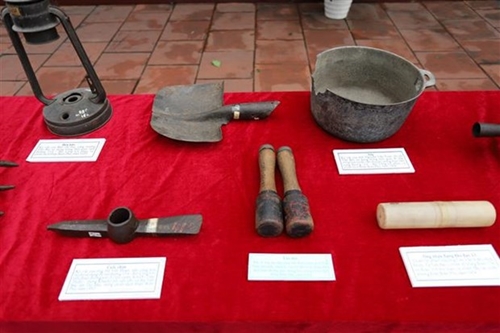Many artifacts were collected from historical places and witnesses such as submachine guns, rifles, defensive shirts, rice sacks, and emulation flags.
Hoang Tien Long, Director of the Yen Bai Museum, said that documents created in the 1952 – 1954 period mentioned historical circumstances, policy decisions and the process of direction and leadership of the Yen Bai provincial Party Committee in preparing conditions and participating in the Dien Bien Phu Campaign.
He said that many photos and artifacts were made public for the first time, showing the great sacrifice, solidarity and high determination of the people of Yen Bai province for the campaign.
    |
 |
|
Artifacts related to the opening of Route 13A - one of the vital routes for transporting troops, weapons, and food to the Dien Bien Phu battlefield. |
Meanwhile, nearly 100 photos that are introduced to the public for the first time truly and vividly reflect the contribution of the people of Yen Bai to the campaign, specifically in supplying food and weapons to the Dien Bien Phu battlefield, or opening roads.
During the Dien Bien Phu Campaign in 1954, Lung Lo pass in Thuong Bang La commune, Van Chan district, Yen Bai province, was one of the vital routes for transporting troops, weapons, and food to the Dien Bien Phu battlefield.
For the campaign, the Party Central Committee decided to open route 13A from Hien ferry in Tuyen Quang province, running past Ben Au Lau to the Lung Lo pass to connect with Road 41 (now Highway 6) at the Co Noi T-junction in Son La province.
The trail stretched 120 kilometers over high mountains and across three big rivers – the Chay, the Red, and the Da. The Lung Lo pass, one of the most treacherous sections, had a steep mountain on one side and a deep abyss on the other.
More than 124,000 sappers and civil workers used millions of bamboo plants and trees contributed by local people to build the route through the Lung Lo pass in about 200 days. Tens of thousands of trucks, carts, and pack-bikes carried weapons and food to the battlefield.
To obstruct the supply route to Dien Bien Phu, the French military dropped about 12,000 tons of bombs on the Lung Lo pass. Some days they dropped as many as 200 bombs. During the campaign, 16 to 18 enemy planes bombed the area five to six times a day.
But tens of thousands of people bravely risked their lives under bombs and bullets to keep the road clear for undisrupted transport. Dozen thousands of tons of military equipment, weapons, and food were stockpiled at Thuong Bang La and transported across the pass to the battlefield.
Source: VNA